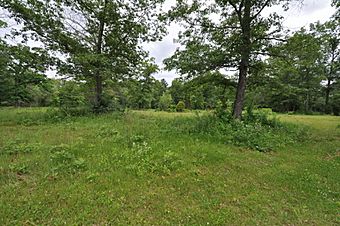Tobin's Beach Site facts for kids
|
Tobin's Beach Site
|
|
 |
|
| Lua error in Module:Location_map at line 420: attempt to index field 'wikibase' (a nil value). | |
| Location | Brookfield, Massachusetts |
|---|---|
| NRHP reference No. | 86003808 (original) 100003227 (increase) |
Quick facts for kids Significant dates |
|
| Added to NRHP | July 22, 1986 |
| Boundary increase | December 17, 2018 |
The Tobin's Beach Site is a very old archaeological place in Brookfield, Massachusetts. It shows us how people lived long ago. This special site was found in 1963. It is one of the few places in New England that has signs of the Adena culture.
The site was added to the National Register of Historic Places in 1986. This means it is an important historical spot. More of the site was added to the list in 2018.
Contents
Discovering Tobin's Beach Site
The Tobin's Beach Site was found in 1963. It was located on a local campground. When people first looked at the site, they found fourteen ancient graves. These graves held clues about the people who lived there.
What Was Found at the Site?
Archaeologists found several interesting items at the site. These items help us learn about the Adena culture. One important find was a clay tube with a hole drilled through it. Another was a stone spear point. This stone came all the way from Ohio.
They also found a series of postholes. These were arranged in a half-circle shape. This pattern suggests that a wigwam once stood there. A wigwam is a type of home used by Native American people.
The Ancient Adena Culture
The Adena culture was a group of Native American people. They lived in parts of North America a very long time ago. This was between about 1000 BC and 200 AD. They are known for building large earth mounds. These mounds were often used for burials.
The Adena people also made special tools and art. Finding their artifacts at Tobin's Beach shows they traveled. It also shows they had connections far away, like to Ohio.
The Nipmuc People's Connection
The Tobin's Beach Site is very important to the local Nipmuc people. They are a Native American tribe from this area. The Nipmuc people believe this site is an ancestral graveyard. This means it is a burial ground for their ancestors. It is a sacred and respected place for them.

